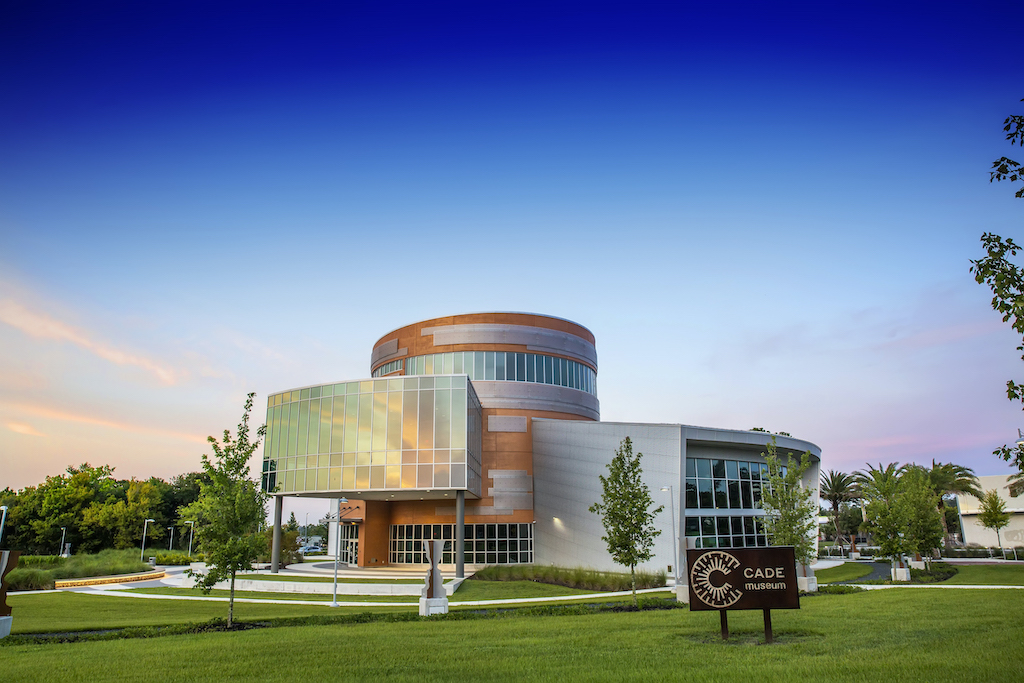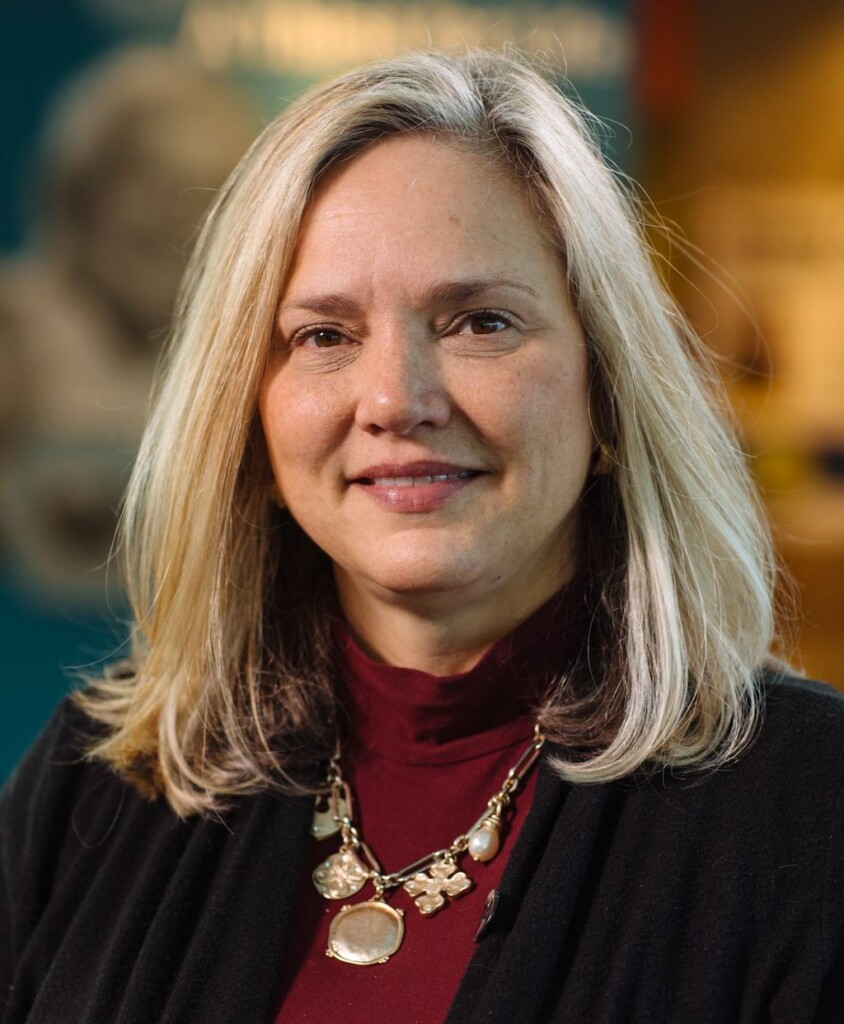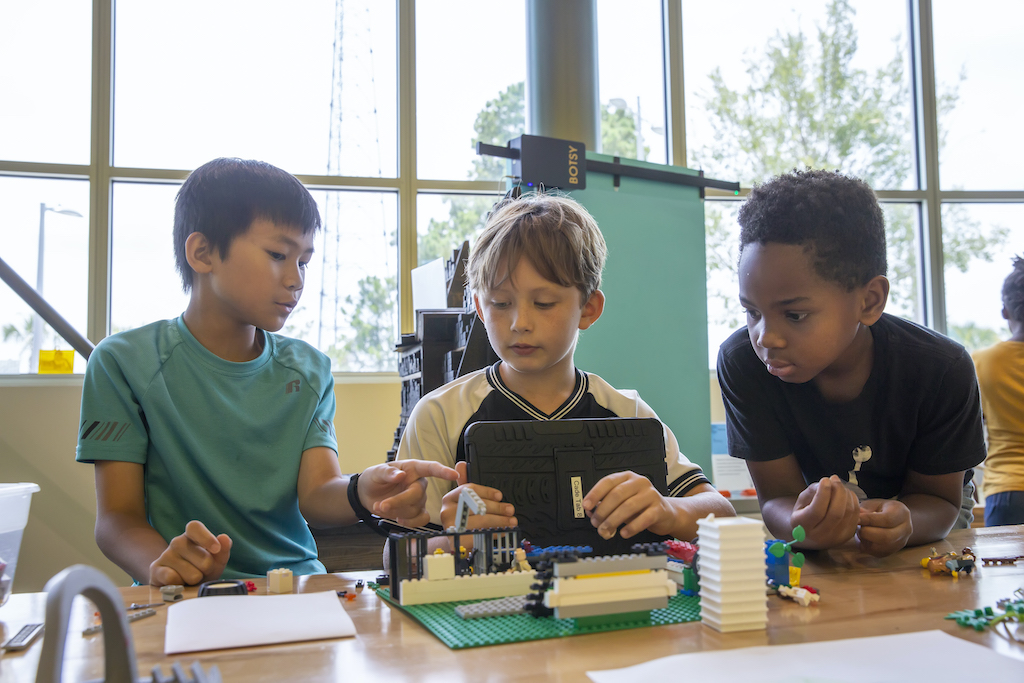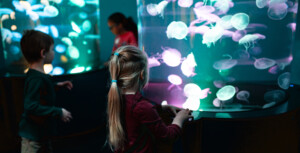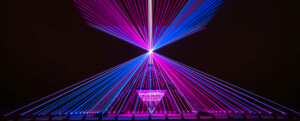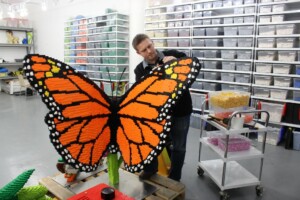Stephanie Bailes, president and CEO of the Cade Museum for Creativity and Invention, was brought in as executive director in 2017, with a mission to restructure the institution, complete a $12 million construction project and expand the museum’s programming. She was appointed to the Board of Trustees in November 2020 and then promoted to CEO in 2022.
During this period, she has grown the team from four employees to 36. She has also raised more than $4 million, as well as working on education curriculum development. Over 100,000 people have visited the Cade Museum for Creativity and Invention in Gainesville, Florida, since it opened.
Bailes has over 20 years of management experience in non-profit, corporate, and entrepreneurial environments.
Before joining the Cade Museum, she held a variety of leadership roles. This included positions at the Chi Omega Housing Corporation, Pennington & Bailes, the American College of Cardiology and Special Olympics International, crafting organisational strategy, aligning organisational units around corporate strategy, and developing processes, budgets, and metrics to meet, fund, and measure those plans.
She holds a BA in Sociology from the University of Florida, and, before her career in business management, worked as a front-line provider in Children’s Home Society foster care facilities and for the state of Florida’s Child Protection Team. Bailes has served on local and national Boards of several organizations, most recently having served for six years on the University of Florida Alumni Association Board of Directors.
A varied career
Outlining her background, an unconventional one in the museum sector, Stephanie Bailes tells blooloop:
“When I was little, I always wanted to be a paediatrician. I loved kids and wanted to help them. As I started moving through school, I realised that my skillset leaned more toward English and writing, and was less science-oriented. When I got to college, I decided I was going to study sociology and become a social worker.”
In college, she had a variety of internships.
“One of my first jobs out of college was working in an emergency shelter for girls; my second job was working for something called the Child Protection Team,” she says. “I did crisis intervention for sexually and physically abused children. I would be the first person that was called in the middle of the night.”
Life before the Cade Museum
This emotionally draining experience led her to the realisation that she did not want to be on the front line. Instead, she decided to gain business skills, and return to the nonprofit sector as an administrator. She started working for a telecom company in Atlanta, then was hired first by a startup company in Atlanta, and by another company in Washington, DC.
“Soon, I gained a reputation in the telecommunications industry, in these startup environments, as someone who could just make things happen,” she explains:
“I ended up moving away from sociology. I went through marketing: product marketing, product development, marketing communications, and then moved into finance. That’s where I really learned how businesses operate, and the rhythm and pace of organisations. I spent most of the latter part of my career doing strategic planning, working with executive teams, and navigating pathways for growth and development of these startups.”
Building on real-world experiences
Finally, she got to a point where she was ready to return to her roots:
“I was hired by Special Olympics International to put together their first global planning process. It was amazing: 72 countries, five regions, and a million athletes, at that time. They had never really been able to coordinate the movement in that way, and I was the leading edge of a culture shift in that.”
This, she explains, is her background, in a nutshell: “I always wanted to help people. I went into business, and then I gained real-world experiences.
“Somehow or another, I found myself in Gainesville talking to Phoebe Miles, who is the founder of the Cade Museum, and an incredible storyteller.”
Miles shared the museum’s mission: to transform communities by inspiring and equipping future inventors, entrepreneurs, and visionaries, and its vision: to spread an inventive mindset across the world.
“The more we talked about it, the more enamoured I became. When she suggested I should come and run this museum, I was shocked: me? A museum? I’d never run a museum. But then I realised -this is a startup; I had 20 years of experience in startups. It was also about all the things I love: invention, product, entrepreneurship, community, and children.”
She realised this was something she was equipped to do.
“I am very unconventional. We are not a museum of things, we’re not focused on maintaining collections. We’re really focused on ideas, and on being at the forefront of technology and innovation. If you look at it in that way, I’m actually a good fit.”
Stephanie Bailes and the Cade Museum
When Bailes took over the organisation, the building was about 35% completed.
“I walked into the middle of it,” she says. “It was a very rapid lesson. I’ve always worked with large complex projects. On one occasion, with an organisation I worked with, we had a $2 billion capital budget, and we did network rollouts across the entire country, as well as some internationally. I was familiar with construction, large numbers, and project management.”
Nevertheless
“This was a steep learning curve. It was a big project and a challenge.”
She embraced it, developing close relationships with the construction manager and project team.
“I leaned on their advice and expertise. But at the end of the day, I had to make the decisions, and own them.”
It is a huge achievement and a most unusual museum.
“It’s unlike anything else for a variety of reasons,” Bailes says:
“I think the first is that, because it is a museum of ideas, we’re constantly changing. Every 12 to 16 weeks you’ll have a new experience when you come in. To develop that type of fluid environment is an organisational challenge in itself, but that’s where my corporate experience played a tremendous role, in enabling us to build an organisation that would support that rapid change of information and ideas.
“I’ve built this museum as if it were a company that develops products for market implementation.”
Innovative programming
The Cade Museum’s primary programming innovation is an educational concept initially envisioned by the museum’s founder, the Pillars of Science and Building Blocks of Invention. It teaches primarily science concepts, incorporating the arts and early learning development, exploring these concepts through the lens of invention.
Bailes explains:
“That’s where our programming is innovative. For a lot of science museums and STEAM centres, the science is in pieces; they are concepts that people learn. This framework that we have, which uses the lens of invention, provides a holistic approach to acquiring STEAM knowledge, skills, and experiences. It makes it more intentional.”
She returns to the museum’s mission, which is to transform communities by inspiring and equipping future inventors, entrepreneurs, and visionaries. What does it mean in real-world terms, addressing issues such as the insufficient number of women in STEM, or reaching under-served communities and new audiences?
“I’ll talk about ‘inspiration’ first,” she says:
“I can tell you two stories, an adult story, and a child story. Almost 17 years ago, when Phoebe started talking about innovation and the innovation economy, especially in this area of Florida, no one was having this conversation. ‘Innovation’ wasn’t part of the lexicon. So she and her team developed something called the Cade Prize for Innovation, which is now in its 13th year.”
The Cade Prize
Since 2010, the $50,000 Cade Prize has celebrated innovation by identifying, recognising, and celebrating inventors and entrepreneurs. As one of the largest cash prize competitions for innovation in Florida, the Cade Prize has drawn hundreds of creative thinkers from Pensacola to Miami, with cutting-edge inventions that have real market potential.
“The Cade Prize was the first prize in Florida, if not one of the first prizes in the US, that identified and rewarded early seed-stage ideas,” she says:
“When you think about inspiration, fast forward to now, and there are prizes all over the state of Florida for innovative ideas, innovative companies. In fact, in Tampa, Florida, they have created this huge innovation ecosystem that is rooted in something called Synapse. Here in Gainesville, we have the Innovation Hub.”
“In that story, in terms of inspiration, you can see how innovation has been adopted at least in our state, and you can’t discount the level of influence that those early conversations had on that development. Tip of the spear, if you will.
“If you talk to a lot of kids that come into our world, they either want to be a YouTube star or they want to be a sports star. The Cade has inspired many of these children, through the storytelling of invention and through educational experiences, to look beyond that limited worldview, and to see the possibilities that are around them.”
The Cade Museum & communities
“We take those possibilities for granted,” she adds:
“I recognise that my parents knew what was out there in the world, and they were able to encourage me to seek. In Gainesville, however, you know, 30% of our population lives at the poverty level or below. The location we chose for the Cade was intentional because within a mile of the museum almost 90% of the families live in poverty, or below the poverty line. You can’t discount the impact of hearing these stories on these children and their families.”
Transforming communities is, she maintains, key:
“It’s ‘communities’ in the plural. Going back to a corporate and business culture analogy, we use our museum as our R&D lab to develop the invention-based educational programming that we then intend to move throughout the world.”
Working in partnership
This, she explains, will begin like any market rollout strategy:
“First, you have to develop your minimum viable product; then you have to test and refine it, and then you have your Version One. What we’re doing now is testing outside of our museum. We’re moving out into surrounding counties, and are testing what infrastructure is needed to support that movement and that outreach. I have an expansion strategy – it’s just to move farther afield from home.”
She is in conversation, additionally, with international development organisations:
“We are discussing how we might undertake testing in certain areas so that we can develop that kind of organisational muscle. Nothing has been finalised yet, but we are having those conversations.”
The digital space
The digital space is another area of expansion.
“Our Pillars of Science, that educational framework that we’re developing, will be our primary representation in the digital world. The system is still under development.”
The necessity to deal with the challenges of the COVID-19 pandemic slowed progress, she explains:
“We coped through tenacity, grit, persistence, maybe a glass of wine or two,” she says. “My original expansion strategy focused on refining everything in the museum; getting our in-museum experiences nailed down, and bringing people from outlying areas to the museum so that I could take advantage of existing resources and infrastructure.”
“COVID flipped that around: we couldn’t be in-person.”
Accordingly, she explains:
“What it forced us to do was to start exercising that organisational muscle to move out into the community. We developed a mobile lab. So, when schools were shut down or were not able to come to field trips, we would bring the Cade to the school and set it up in the parking lot. Effectively, it moved our outreach strategy forward faster than I thought we would go.”
Creativity and innovation at The Cade Museum
The Cade is a museum celebrating creativity and invention:
“If we couldn’t pivot, then we would not be living our mission. It was an immense pressure to show what our DNA is, and what we’re about; to show how we could lead in that way. We were one of the first organisations to open back up in Gainesville, certainly, in the museum world. We were open a year before other museums and cultural institutions were open, in some cases.”
She explains one reason that the Cade Museum was able to do that was a partnership with a company, Violet Defense:
“We live in a technology innovation space, so we know companies that are developing leading-edge technologies. One of these companies is Violet Defense, out of Orlando, Florida. They developed pulsed Xenon UV disinfection devices, and they donated these systems so that the Cade was able to install Violet Defense technology across the premises to disinfect the air and surfaces and protect museum employees and visitors.
“It meant the museum could successfully reopen on 5 June 2020. Not only was it good for guests, but it made our staff feel comfortable to come in and be together.”
COVID relief
The Cade also developed partnerships to bring free internet access to families with school-aged children.
“Later on, COVID relief packages had federal funding for internet access. But, to go back to the community as part of our strength, everything we do in the museum is for outreach. Our heart lies with being a bridge to the innovation economy for those who don’t have equity and access.”
“Learning from home is great if you have a computer, and if you have internet. But we work in areas of our city where the children don’t have computers or internet access. We worked with an internet provider, Cox Communications, to identify families in public housing that did not have internet access, and then we were able to get a grant to subsidise internet access for these families with children so that they could go to school.”
The project points to the divide between those who take basic privileges, such as the internet, space, time and computers, for granted and those to whom they are unattainable.
An aspirational space
This brings Bailes to the museum building itself:
“It’s beautiful inside. It’s soaring, it’s aspirational, it’s full of light and colour. The first time we had children coming into the building, the first school trip, these little kids came in and all of a sudden we heard them going, ‘Aaaaaaah…’ breathing in.”
“I realised that there are a lot of children in our city who have never left Gainesville. They’ve never been in a building that is not a box; a grocery store, an office building, a public service building. Gainesville is a small-ish city, and we don’t have a lot of aspirational spaces. The spaces we do have tend to be on our university campus. But if you don’t feel comfortable going to a university campus, you don’t get access to that.
“These children are now coming into this space, and it’s theirs. It’s aspirational, it’s beautiful. You can’t discount that experience. There is so much that we take for granted, even architectural spaces.”
Thinking out-of-the-box
It is, she says, wonderful that children are experiencing a beautiful, transcendent architectural space for the first time in a context that is to do with learning:
“And, more than that, learning stories that they could assume to be their own,” she adds. “It’s about aspiration, and it’s about inspiration.”
In conclusion, she says:
“Dr Cade was an incredibly interesting man; an out-of-the-box thinker. His favourite quote is from Tennyson’s Ulysses:
Yet all experience is an arch wherethro’
Gleams that untravell’d world whose margin fades
For ever and forever when I move.
How dull it is to pause, to make an end,
To rust unburnish’d, not to shine in use!
“That’s what we’re trying to do. Imagine this is the arch and if we sit here, this is all you ever see. It’s when you move through the arch that your perspective changes and the world opens up around you.
“We want to be here to help people move through their arch, to that broader perspective, to see the possibilities that are in front of them, rather than rusting unburnish’d from not being in use.”

